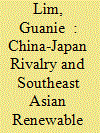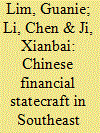|
|
|
Sort Order |
|
|
|
Items / Page
|
|
|
|
|
|
|
| Srl | Item |
| 1 |
ID:
157299


|
|
|
|
|
| Summary/Abstract |
In view of China’s “going out” programme, this article argues that mainland Chinese firms have not made significant breakthroughs in the Southeast Asian automobile sector, primarily because of a competitive and still consolidating marketplace, various national regulations of Southeast Asian countries and the need to dovetail their own corporate goals with those of their Southeast Asian partners. Meanwhile, mainland Chinese firms have made major advances in the Southeast Asian electronics sector by offering low prices and high-quality products and services. In addition, they also collaborate with marketing firms that possess intimate knowledge of the marketplace.
|
|
|
|
|
|
|
|
|
|
|
|
|
|
|
|
| 2 |
ID:
185235


|
|
|
|
|
| Summary/Abstract |
In recent years, China and Japan have increasingly competed against each other over infrastructure provision in Southeast Asia, their near abroad. Through an analysis of energy infrastructure provision in Indonesia, this article argues that Indonesia has benefited from Chinese and Japanese financial resources in providing energy to otherwise remote and isolated communities. However, Indonesia’s domestic interest groups and its political economic structure have promoted nonrenewable energy adoption at the expense of renewable sources. Indeed, Indonesia’s demand for nonrenewable energy has opened up opportunities for both Chinese and Japanese firms. While Chinese firms have definitively grown their market share in nonrenewable energy infrastructure, especially coal-fired power plants, so too have their Japanese counterparts. The emphasis on coal-fired power has not only hindered renewable energy expansion, but also led to ecological damage. Furthermore, several Indonesian private firms with long-standing interests in coal mining and processing have forged collaborative ties with the Chinese and Japanese firms to enter the business of operating coal-fired power plants, while securing a captive market for their coal supplies. These findings illustrate that China-Japan competition is more complex than commonly portrayed, in addition to raising questions about Chinese and Japanese claims of a “green” Belt and Road Initiative and Partnership for Quality Infrastructure, respectively.
|
|
|
|
|
|
|
|
|
|
|
|
|
|
|
|
| 3 |
ID:
185987


|
|
|
|
|
| Summary/Abstract |
Since 2013, the Belt and Road Initiative has become China’s signature foreign economic policy campaign. While there have been debates on the initiative’s implementation and implications, an emerging consensus suggests that the export of capital-intensive infrastructure is a key driving factor of China’s financial statecraft. For Southeast Asian countries, such Chinese efforts are useful in plugging their domestic infrastructure gaps, not least in the remote parts of their territory. Against this backdrop, this article examines arguably two of the most prominent Chinese infrastructure projects in Malaysia – the East Coast Rail Link (ECRL) and the Malaysia-China Kuantan Industrial Park (MCKIP). It posits three inter-related arguments. Firstly, unlike conventional analyses which commonly treat the Chinese state as a singular, unitary actor, both the central and provincial governments in China’s multi-layer state structure have played important roles and demonstrated different characteristics in Chinese infrastructure overture towards Malaysia. Secondly, one observes contrasting patterns of well-coordinated state-business relations in the ECRL project versus loose, decentralised state-business relations driven largely by Guangxi province and market forces for the MCKIP. Thirdly, the implementation of both the ECRL and the MCKIP has been heavily constrained by the political-institutional environment of Malaysia as the host country, illustrating that Chinese financial statecraft, in the form of infrastructure provision, generates considerably less impact than what popular rhetoric suggests.
|
|
|
|
|
|
|
|
|
|
|
|
|
|
|
|
|
|
|
|
|